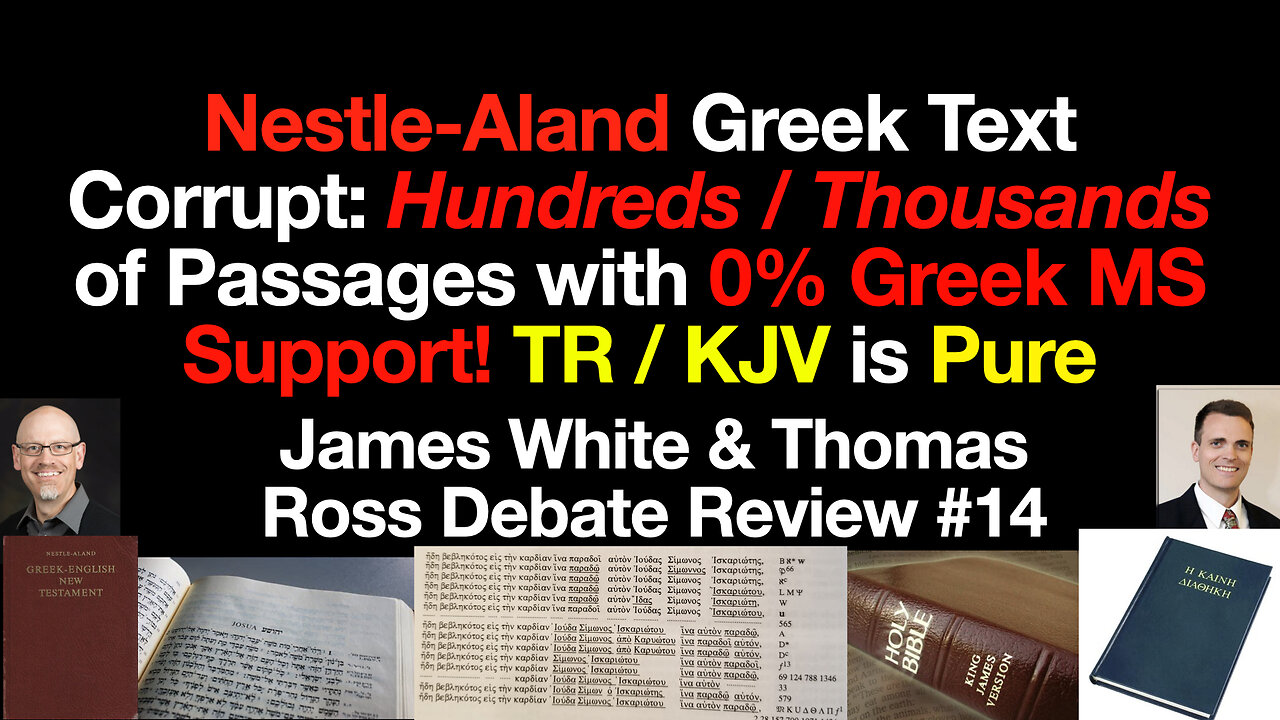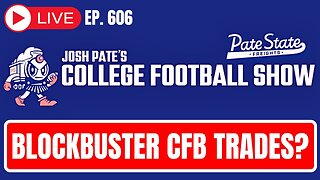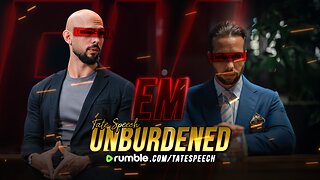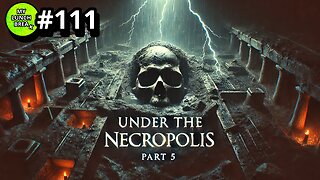Premium Only Content

The Nestle-Aland Greek Text is Corrupt: 0% Greek Manuscript Evidence: KJV & Textus Receptus Are Pure
The Nestle-Aland or United Bible Society Greek text upon which the vast majority of modern English Bible versions is based (NA27 or NA 28, UBS4 or UBS5) is corrupt: it is the Textus Rejectus. HUNDREDS of small segments of its text have 0% support from any extant Greek manuscripts known to exist in the world. THOUSANDS of small sections of its Greek text do not look like any actual Greek manuscript on earth. Furthermore, in well over 10,000 variants the Nestle-Aland critical Greek text rejects 90% or more of Greek manuscripts. By contrast, the Greek Textus Receptus or Received Text (TR), the basis for the Authorized, King James Version of the Bible (KJV / KJB / AV 1611) and other widely used Reformation-era Bibles in many languages, is based on the overwhelming majority of Greek manuscripts the overwhelming majority of the time.
The Bible teaches the providential preservation through God’s singular care and providence of every single word in the infallible original manuscripts (Matthew 4:4), the perpetual availability of those words (Isaiah 59:21), and the recognition of those canonical words by true churches (1 Timothy 3:15). The Received Text fits that model; the Nestle-Aland Textus Rejectus does not. This fact requires a TR-only, King James Only, or Confessional Bibliology approach to the preservation of the inspired Word of God.
In this video, which is also debate review video 14 in the James White / Thomas Ross debate “The Legacy Standard Bible, as a representative of modern English translations based upon the UBS/NA text, is superior to the KJV, as a representative of TR-based Bible translations,” every single variant in John 13 between the Textus Receptus and the Nestle-Aland Greek text is examined. Every variant between the Received Text and the modern printed Majority Text editions by Zane C. Hodges and Arthur L. Farstad’s The Greek New Testament according to the Majority Text, Maurice Robinson and William Pierpont’s The New Testament in the Original Greek: According to the Byzantine/Majority Textform, and Wilbur N. Pickering’s The Greek New Testament According to Family 35 are also examined.
In John 13 alone, the Nestle-Aland text rejects:
90% or more of Greek manuscripts 43 times
95% or more of Greek manuscripts 42times
99% of Greek manuscripts or more 28 times
99%+ of Greek manuscripts 18 times
100% of Greek manuscripts in John 13:2.
Extrapolating for the entire New Testament from John 13:
The Nestle-Aland text rejects:
99% of Greek MSS c. 4,680 times
90%+ of Greek MSS c. 11,180 times.
When the Received Greek text from which the King James Version was translated varies from the Nestle-Aland Greek text from which modern Bible versions come (NIV, LSB, NASB, NRSV, ESV, NLT, etc.), the TR usually follows by far the greater number of Greek manuscripts. When they differ, the Textus Receptus receives support from:
90% of Greek manuscripts or more 42 times
95% of Greek manuscripts or more 40 times
99% of Greek manuscripts or more: 18 times
99%+ of Greek manuscripts: 11 times
Furthermore, an examination of Dr. Reuben Swanson's New Testament Greek Manuscripts: Variant Readings Arranged in Horizontal Lines Against Codex Vaticanus: John, as well as his other volumes in this series (Matthew, Mark, Luke, Acts, Romans, 1 Corinthians, 2 Corinthians, and Galatians), shows that there are huge numbers of short sections of Greek text where no manuscript on earth reads exactly like the printed United Bible Society Textus Rejectus. For slightly larger sections of text, thousands of passages do not look like any extant manuscript. By contrast, the Received Text is identical to large numbers of Greek MSS in verse after verse, paragraph after paragraph, page after page, book after book.
Eberhard Nestle himself (of NESTLE – Aland fame) admitted: “The text of our present critical editions is a patchwork of many colours, more wonderful than the cloak of Child Roland of old. In fact, it is a text that never really existed at all.” Nestle himself, of Nestle-Aland fame, admits that the Textus Rejectus type of Greek text is a “patchwork,” “a text that NEVER REALLY EXISTED AT ALL”!
The Received Text is very similar to all the three Majority Text editions in John 13:
TR differs from Wilbur Pickering: 15 letters in 6 words
TR agrees with WP in 662/668 words = 99.1% of words
TR agrees with WP in 3,008/3,023 letters = 99.5% of letters
TR differs from Hodges-Farstad: 9 letters in 3 words
TR agrees with HF in 665/668 words = 99.6% of words
TR agrees with HF in 3,014/3,023 letters = 99.7% of letters
TR differs from Robinson-Pierpont: 9 letters in 3 words
TR agrees with RP in 665/668 words = 99.6% of words
TR agrees with RP in 3,014/3,023 letters = 99.7% of letters
The printed Majority Text editions are very similar to the Received Text in John 13. Where they differ, the Textus Receptus follows the absolute majority of Greek manuscripts MORE than any of the so-called modern printed Majority Text editions.
-
 2:15:15
2:15:15
vivafrei
22 hours agoEp. 249: Confirmation Hearings RECAP! Canada-U.S. TRADE WAR? Bureaucrats Sue Trump! Viva Barnes Live
192K441 -
 4:51:59
4:51:59
MyronGainesX
15 hours agoIRS Auctions Off Tekashi 69's Possessions
198K28 -

Vigilant News Network
1 day agoRFK Jr. Hearing EXPOSES Corrupt Politicians in Humiliating Scandal | Media Blackout
203K57 -
 1:11:40
1:11:40
Josh Pate's College Football Show
14 hours ago $6.33 earnedPerfect CFB Conferences | Big Ohio State Changes | Canceling Spring Games | SEC 2025 Thoughts
73.8K2 -
 1:08:07
1:08:07
Bek Lover Podcast
12 hours agoInteresting Times with Bek Lover Podcast
41K -
 1:51:12
1:51:12
Tate Speech by Andrew Tate
15 hours agoEMERGENCY MEETING EPISODE 105 - UNBURDENED
224K112 -
 1:01:18
1:01:18
Tactical Advisor
18 hours agoBuilding a 308 AR10 Live! | Vault Room Live Stream 016
200K20 -
 2:17:02
2:17:02
Tundra Tactical
1 day ago $30.57 earnedTundra Nation Live : Shawn Of S2 Armament Joins The Boys
282K29 -
 23:22
23:22
MYLUNCHBREAK CHANNEL PAGE
2 days agoUnder The Necropolis - Pt 5
221K71 -
 54:05
54:05
TheGetCanceledPodcast
1 day ago $15.36 earnedThe GCP Ep.11 | Smack White Talks Smack DVD Vs WorldStar, Battle Rap, Universal Hood Pass & More...
210K36